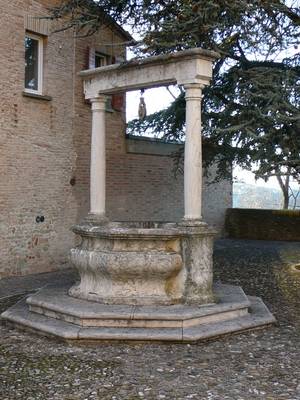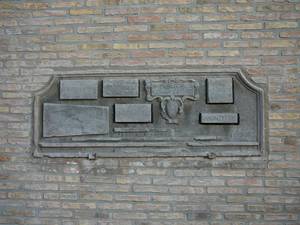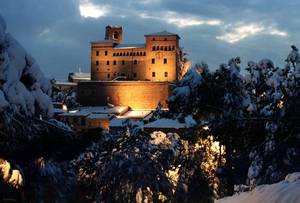‹‹ You have clouds mountain seas the dust of the seasons (…) ››
Tito Balestra, You have clouds seas mountains, from If you have a mountain of snow keep it in the shade, Garzanti, 1979
Longiano Castle, photo by Viterbo Fotocine
The castle stands on a hill at 179 m above sea level. It was originally created as a military stronghold with a double wall against the Lombard incursions. It later changed its use several times, becoming first a noble residence, then the premises of the town administration and finally the current museum of modern and contemporary art. Since its inception, the castle has experienced the historical-military events that have characterised this area, as mentioned by sources from 1059. It was the subject of many destructions and devastations over the centuries, which earned it the title of “fired village”. It was after one of these episodes that in 1295 Giovanni Malatesta, lord of Rimini, decided to equip the village with new bastions, which correspond with the current terrace. Towards the end of the 12th century new parts were added, including the keep and the spiral staircase, which were later incorporated in the subsequent Renaissance expansion, as well as the civic tower, also called the bell tower as it houses the public bells. For two centuries, the castle remained the property of the Malatesta family, who provided it with two walls surmounted by walkways. Today, the three gates remain: the Circle Gate or Castle Gate (equipped with a turret), the Intersection Gate (two roads branched off from here) and the Drawbridge Gate.

- Venetian well located in the Carlo Malatesta court
Carlo, the last member of the Malatesta family, died in 1429 in the castle. The courtyard of the castle is still dedicated to him today. Following his death, the family’s properties were acquired first by the Papal state and in 1503 by Cesare Borgia, lord of Cesena. However, the village never accepted Cesare Borgia’s domination, and as a consequence, it was heavily punished. It was in this period that the ancient town archive was lost. Between 1503 and 1506 there was a short Venetian domination, during which the well located in the courtyard was constructed, while the two columns and the header were added later.
In 1519 Pope Leo X granted this feud to Guido Rangone, count of Modena and former adviser to the king of France. During this time, the castle was converted into a residence, by losing the defensive characteristics, lightening the walls and creating the loggias. Baldassarre was the architect of the grotesque decoration of the ceiling of the study located on the first floor of the keep. He was the last descendant of the dynasty and died in 1581.
In the 16th century, public works were carried out to add the abacus bearing the linear measures and the brick material. The mount of piety was also established in the keep.

- Table with linear measures and bricks
Further changes were made in the 19th century, when the building became the town hall. At this time the central body between the two towers was raised and the Council room was renovated and decorated by Giovanni Canepa and Girolamo Bellani. The adjacent room was raised and deprived of rosettes on the ceiling and of baroque seats near the windows. The latter room was also decorated by the same artists with a frame bearing the effigies of the most famous local personalities.
At the beginning of the 20th century, the south-east tower was lowered to the level of the terrace, and subsequent renovations and restoration works were carried out following the war damages to the civic tower, as Longiano was a cornerstone of the Gothic line in 1944. In 1989 the last considerable change was the movement of the town hall to the premises which are still in use today, while the restored castle opened to the public as a gallery of modern and contemporary art.

